It’s no insult to modern Athens to say the Greek capital reached its zenith 2,500 years ago, under the statesman Pericles. This confident, newly minted democracy had repelled Persian invaders, and Pericles laid out a reconstruction plan that has resounded through the ages.
The Golden Age of Athens has left us with the Parthenon, the sculptural mastery of Phidias, the philosophy of Socrates and Plato, and the tragedies of Sophocles and Euripides.
In the city’s countless archaeological sites you can choose a rabbit hole and go as far as your curiosity will take you. Still, the modern city, home to more than a third of the country’s population, has plenty to inspire wonder.
You’ve got the welcoming alleys of the Plaka quarter, some of the best museums in the world and the awesome architecture of the Stavros Niarchos Foundation Cultural Centre, designed by Renzo Piano.
1. Acropolis
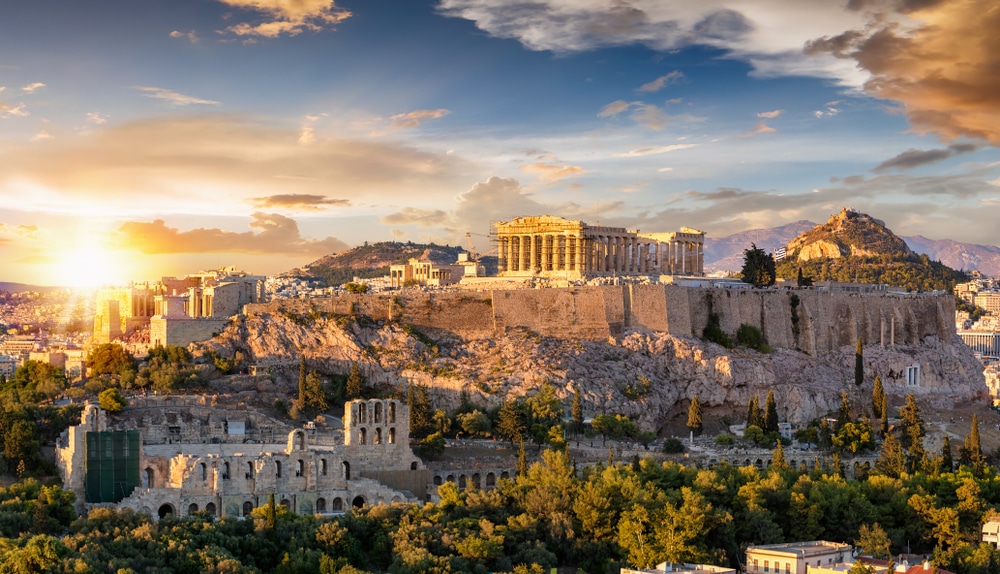 Source: Sven Hansche / shutterstock
Source: Sven Hansche / shutterstockIn the 5th century BCE, some of history’s most talented artists came together to create the greatest ensemble of Ancient Greek architecture.
This is the Acropolis, a sanctuary high on a plinth-like plateau with almost sheer sides that soar above gentle wooded slopes.
The entrance to the Acropolis is suitably dramatic, via the Propylaea, a monumental gateway, monitored to prevent the riffraff from being able to claim the protection of the gods at the sanctuary.
That unmatchable programme of construction under Pericles furnished the Acropolis with the Parthenon, together with marvels like the Temple of Athena Nike and the Erechtheion.
After antiquity, the monuments found new uses, as churches, mosques and palaces, and a brutal blow was struck in an explosion during a siege by the Venetians against the Ottomans in 1687. Decades of forensic restoration ensure that today’s Acropolis is closer than ever to the Acropolis of antiquity.
2. Parthenon
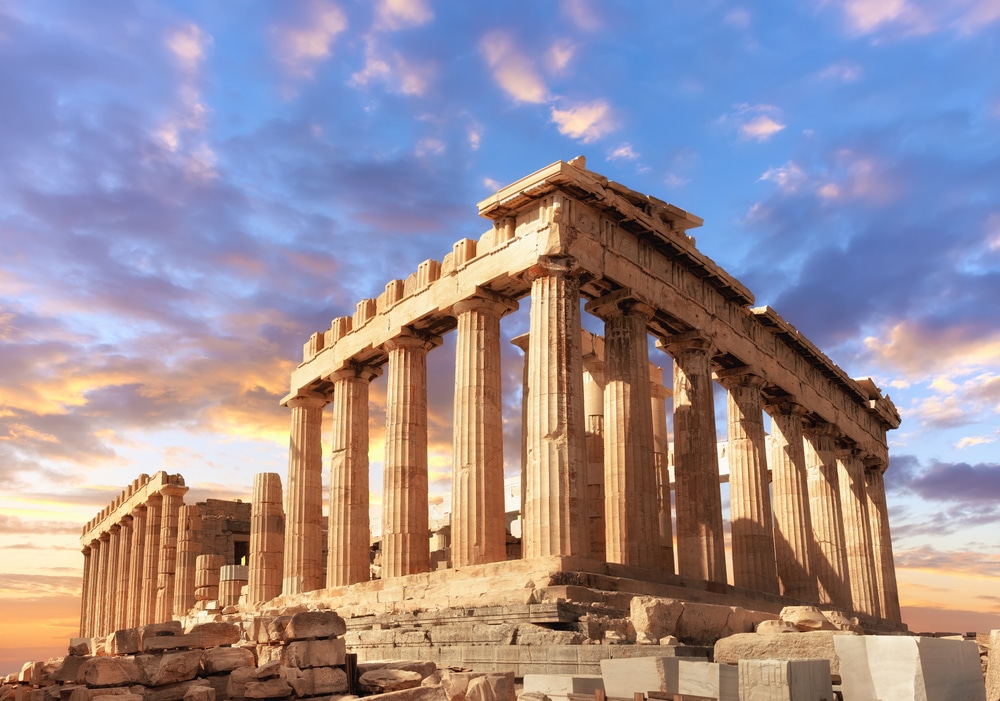 Source: anyaivanova / shutterstock
Source: anyaivanova / shutterstockThis treasury for Ancient Athens temple to the goddess Athena is the crowning glory of the Acropolis and a global emblem for civilisation and democracy.
Still inspiring awe but also academic fascination, the Parthenon is the most fabled building from Pericles’ programme of construction, replacing a temple destroyed by the Persians earlier in the 5th century BCE.
Designed in the Ionic order by a team including Iktinos and Callicrates, the monument is maybe most revered for its masterful sculptural elements by Phidias (480-430BCE), whose Statue of Zeus at Olympia was one of the Seven Wonders of the Ancient World.
Given its age and the turbulent history of Athens it’s no surprise that the Parthenon has had a rocky past. And yet the structure stayed mostly intact until an Ottoman ammunition dump was ignited by Venetian artillery during a siege in 1687.
It was first pieced back together in the 19th century, and is constantly being restored with ever more sophistication and accuracy, as new insights are yielded with each passing year.
3. Acropolis Museum
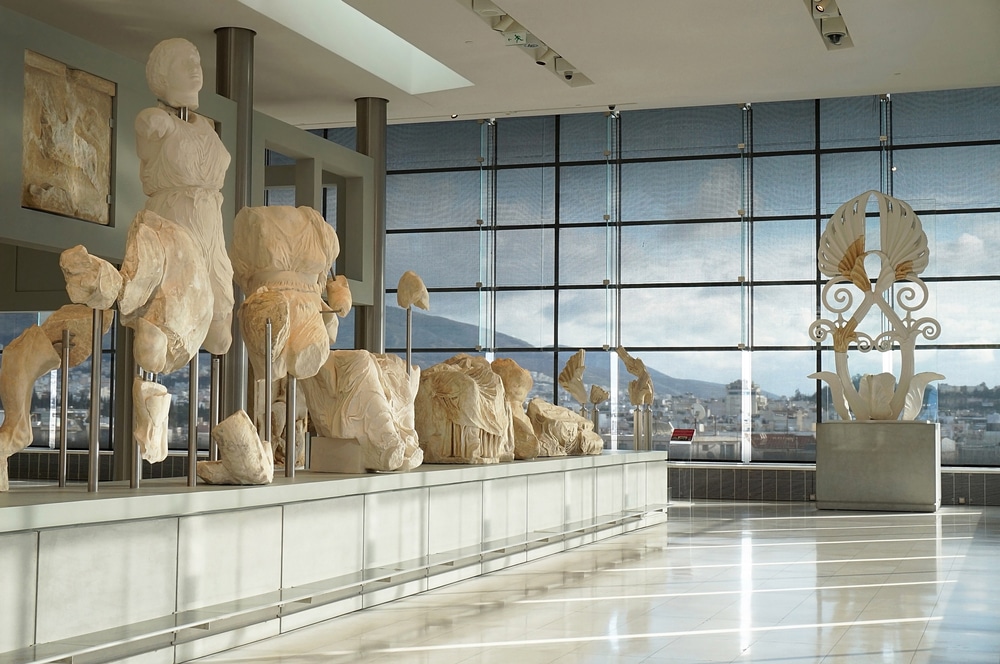 Source: SIAATH / shutterstock
Source: SIAATH / shutterstockAs a chaser you have to visit this museum the moment you get back down from the Acropolis. This opened in 2009, designed by Bernard Tschumi, with a top level dedicated to the Parthenon marbles and set askew from the other floors to line up with that monument over on the Acropolis.
Such is the density of archaeology around the hill that you can view the fabric of Ancient Athens in situ through a glass floor.
The greatest exhibits of course are the many marble sculptural elements from the Parthenon and other buildings on the Acropolis.
An empty space has been made for the Elgin Marbles, which are still at the British Museum, but more than half of all the celebrated frieze, metope, triglyph and pediment carvings are here, as well as five of the world-renowned caryatids from the Erechtheion.
The museum also goes deep into earlier archaeological layers at the Archaic Acropolis Gallery, where you can view the marvellous decoration from the Old Temple of Athena and Hekatompedon, which only survive as foundations today.
Website: https://www.theacropolismuseum.gr/
4. National Archaeological Museum
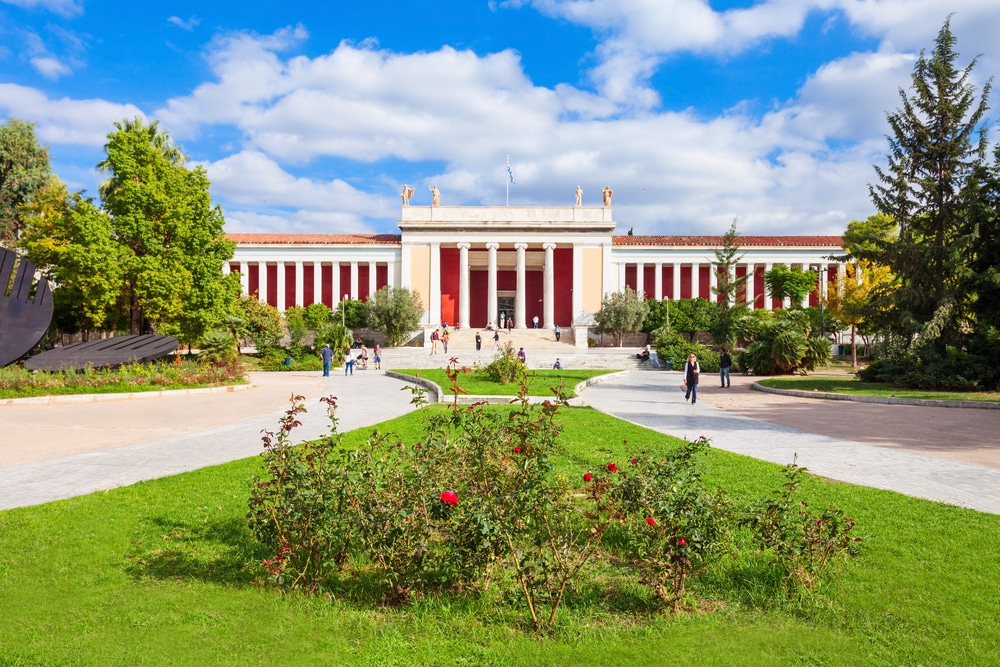 Source: saiko3p / shutterstock
Source: saiko3p / shutterstockThe perfect accompaniment to the wonders of Ancient Athens is this museum founded in the 19th century as a repository for antiquities discovered across the country.
This is Greece’s largest archaeological museum and one of the most important museums anywhere in the world. In an appropriately Neoclassical building you’ll see staggering artefacts organised by period and civilisation, but also by medium.
For instance there are galleries dedicated to Neolithic antiquities, Cycladic art, Egyptian antiquities, Cyprus, Mycenae and Thera, as well as sculpture, glass vases, jewellery, terracotta figurines and metalwork.
If time is of the essence there are some exhibits that demand to be seen. One is the ingenious Antikythera Mechanism from around 87 BCE, dubbed the world’s first analogue computer and discovered at a wreck site in 1901.
Also outstanding are the modern-looking Cycladic figurines dating back as far as 5,000 years, the Mycenaean frescoes from Tiryns, the Mask of Agamemnon from the 16th century BCE and an almost life-size bronze sculpture of a horse and jockey from 140 BCE
Website: https://www.namuseum.gr/
5. Ancient Agora
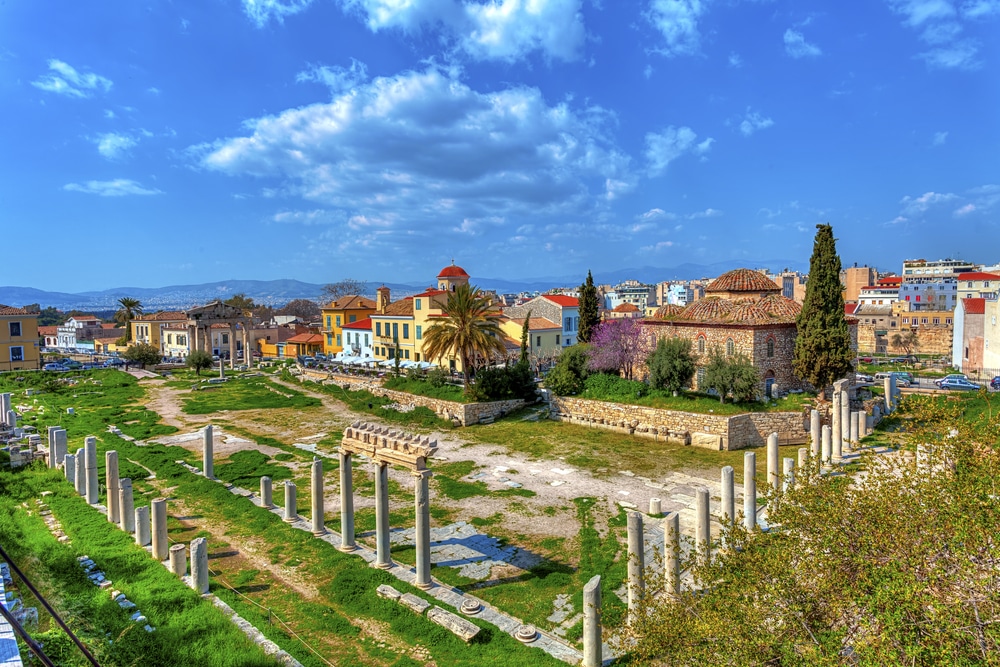 Source: Anastasios71 / shutterstock
Source: Anastasios71 / shutterstockThe flat, green expanse of seemingly random vestiges between the Monastiraki neighbourhood and the Acropolis was the linchpin of everyday life in Ancient Athens.
With a little imagination you can picture the temples, solemn administrative buildings, stoas and monuments that used to crowd this scene.
Around 2,500 years ago you would have rubbed shoulders with the likes of Plato, Socrates and Aeschylus at this place.
Small, informative plaques point out Archaic, Classical, Hellenistic, Roman and Byzantine ruins, as well as the route of the Panathenaic Way to the stadium where the famous games were held.
One building that looks brand new is the Stoa of Attalos, reconstructed by the American School of Classical Studies in the 1950s and 60s and home to the Museum of the Ancient Agora.
This gives a sense of private and public life in Ancient Athens with fascinating artefacts like bronze ballots, weapons, official weights, coins, clay measures, steles, a piece of a marble allotment machine and identification tags.
6. Mount Lycabettus
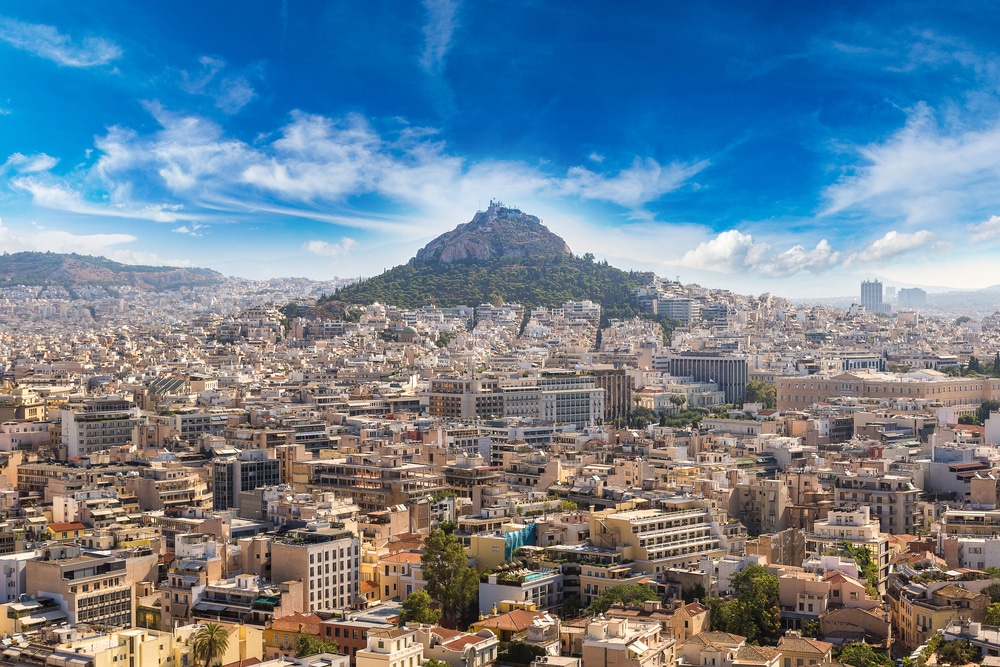 Source: S-F / shutterstock
Source: S-F / shutterstockThe highest natural point in the city is the top of this 300-metre hill, a mass of cretaceous limestone breaking the Athens skyline north-east of the Acropolis.
In Greek mythology, Mount Lycabettus was born when Athena dropped a mountain she had been carrying on her way to building the Acropolis, after receiving sudden bad news from a crow.
At the top is the modern Lycabettus Theatre, an amphitheatre played by some modern legends like Ray Charles, Bob Dylan, James Brown and Joan Baez.
The zigzagging climb is worth doing on foot if you’re feeling fit, but you can also take a funicular from the upmarket Kolonaki neighbourhood at the southern side.
As well as the amphitheatre there’s also a restaurant at the peak, along with the whitewashed church of St George (1870). Needless to say, the view of Athens from the church’s terrace is unforgettable, especially as the city’s lights come on in the evening.
Website: https://www.lycabettushill.com/
7. Panathenaic Stadium
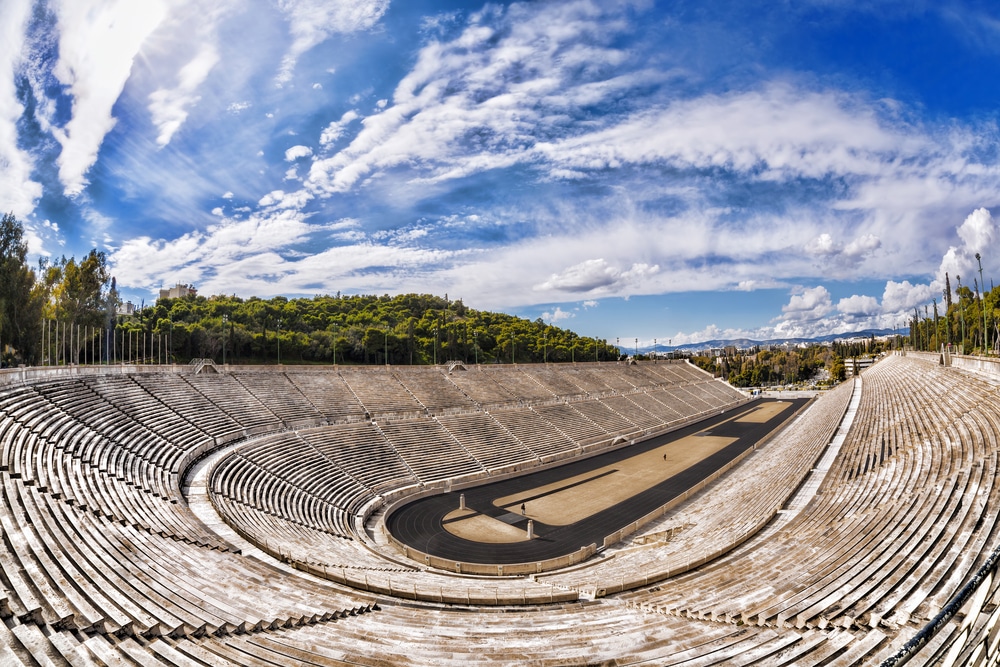 Source: Samot / shutterstock
Source: Samot / shutterstockComposed entirely of marble, the world-famous Panathenaic Stadium is the setting for the handover of the Olympic flame for the summer, winter and youth games.
The first Panathenaic Stadium was built from limestone in the 4th century BCE on the site of a simple racecourse, using the natural slopes of a ravine for its seating.
This was the arena for the namesake games, an ancient forerunner to the Olympics, held every four years, in which nude athletes would compete in events resembling what we know as track and field.
The stadium was rebuilt completely in marble in the 2nd century CE but was abandoned some 200 years later. After being excavated earlier in the 19th century it was restored for the first modern Olympic Games in 1896, hosting four of the nine sports.
This is the monument that greets you today, used in 2004 for the archery competition and as the finish line for the male and female marathons.
Website: http://www.panathenaicstadium.gr/
8. National Garden
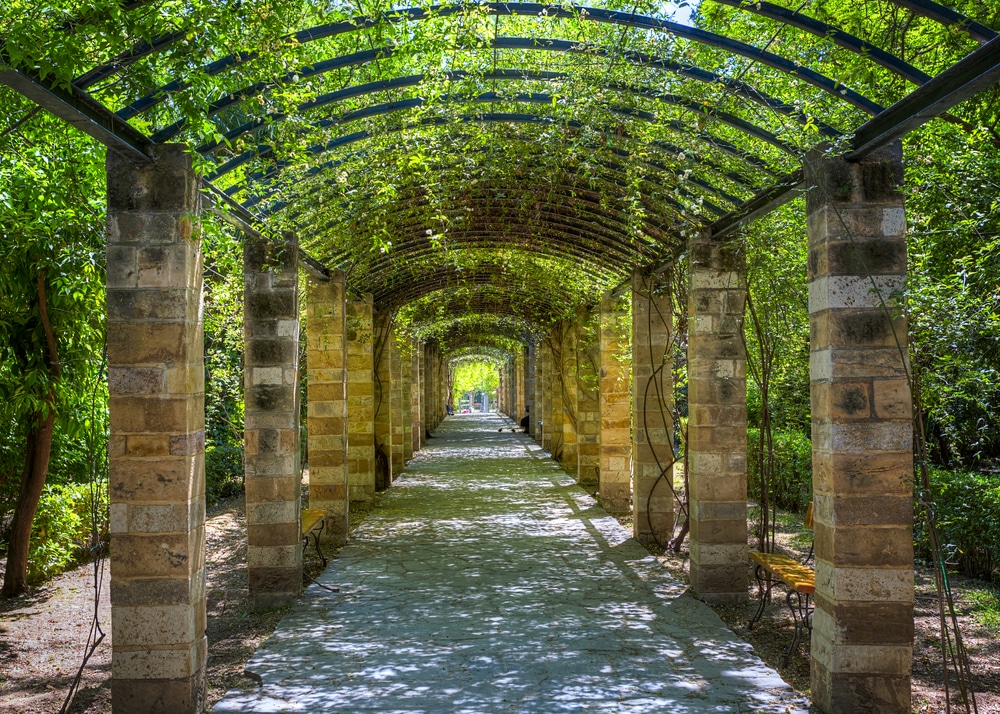 Source: Anastasios71 / shutterstock
Source: Anastasios71 / shutterstockWhen the Old Royal Palace, now home to the Greek Parliament, was being built for King Otto in the 1830s this 16-hectare garden was landscaped at the behest of Queen Amalia.
The abiding image of the National Garden is its twin row of towering palms, and you can get a bit of respite from the chaotic city streets, at the park’s pergolas, shaded walkways, formal gardens and ponds with terrapins and ducks.
There are also little stone reminders of Ancient Athens here and there. The park opened to the public in the 1920s, and was the site of a crucial moment in Greek history.
It was while walking here that King Alexander (1893-1920) was bitten by a pet monkey, and he soon died from the septic wound.
That bite, and his death set in motion a dramatic chain of events, including the Great Fire of Smyrna (1922), that led to the exchange of populations between Greece and Turkey in 1923.
9. Erechtheion
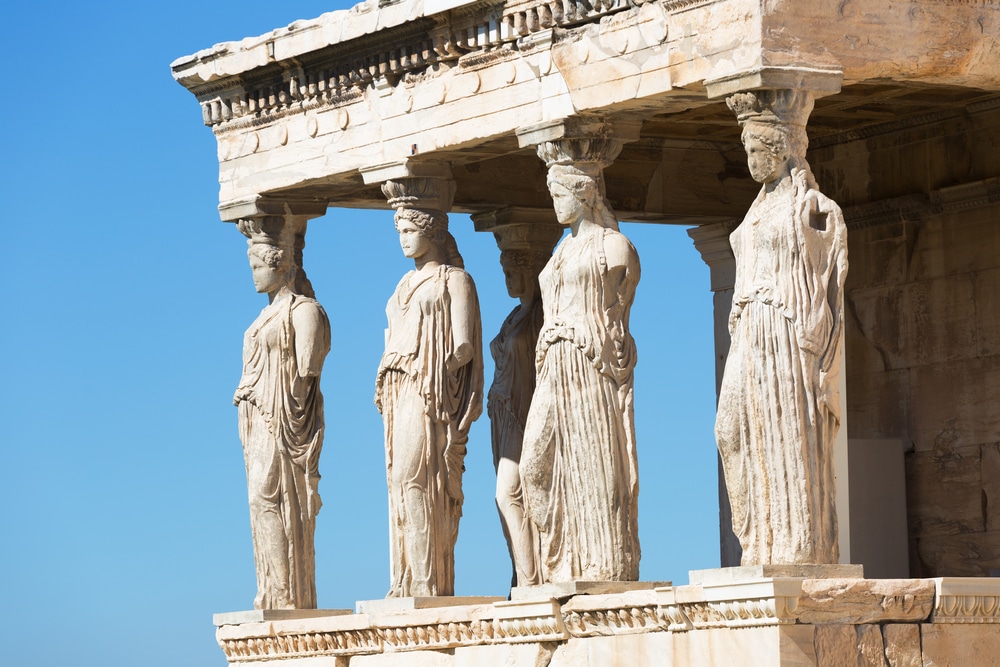 Source: Shchipkova Elena / shutterstock
Source: Shchipkova Elena / shutterstockWhat may be the most exquisite monument on the Acropolis is this Ionic temple on the north side, and also originating in the 5th century BCE.
The unusual footprint of the temple is explained by the irregular topography, with a three-metre height difference between eastern and western portions.
The Erechtheion filled a few different uses after the Ancient Greek and Roman periods, becoming a Byzantine church, then a Frankish palace and later the harem for the Ottoman commander.
The south porch is famous throughout the world for its six caryatids – in fact these draped female figures supporting the architrave are the original caryatids for which the architectural element is named.
What you see are casts, and five of the six originals can be found at the Acropolis Museum, while another is at the British Museum.
10. Theatre of Dionysus
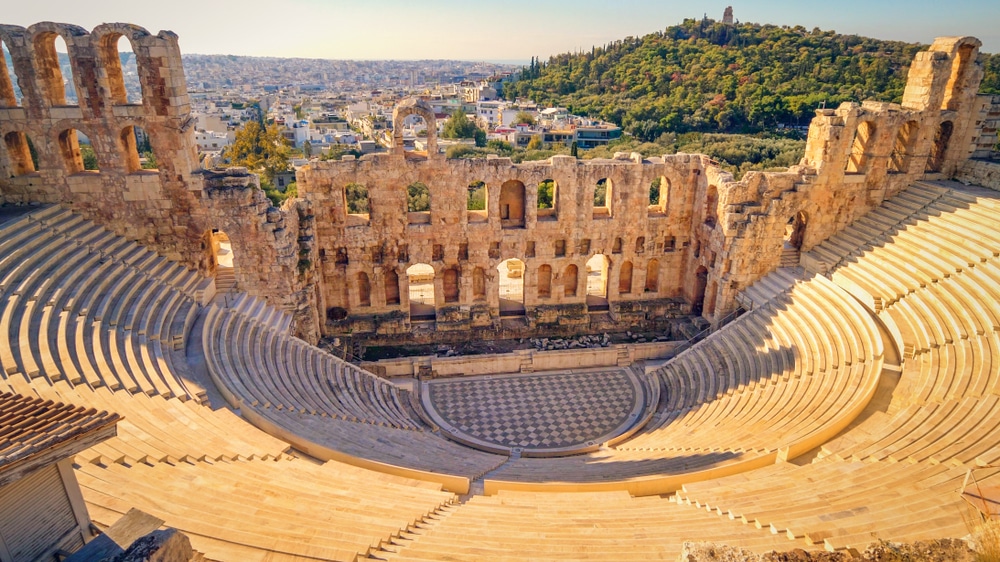 Source: CrackerClips Stock Media / shutterstock
Source: CrackerClips Stock Media / shutterstockYou can’t exaggerate just how vital this theatre on the southern slope of the Acropolis has been to world culture.
As the setting for the festival Dionysia, the likes of Euripides, Sophocles and Aeschylus vied for prizes awarded by a panel of judges.
Something compelling about the theatre is that historians can refer to the 5th-century BCE plays of Aeschylus for instance, to find out details about its original architecture and scenography.
The venue was in use from the start of the 5th century BCE to the late 5th century CE, when it was abandoned, after which the cavea became a quarry.
The site was first excavated in the 1860s and from the reassembled seating the vistas sweep out over the southern quarters of Athens.
Look out for the 3rd-century CE Bema of Phaidros, which served as the stage front, as well as the vestiges of seats of honour in the front two rows, carved with the names of important people who occupied them.
11. Plaka
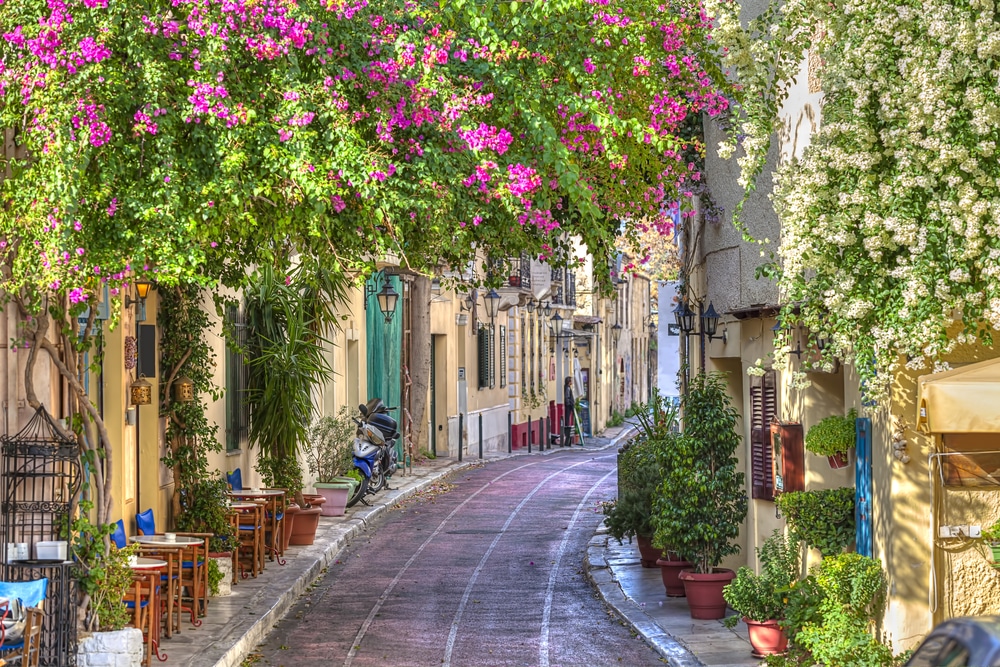 Source: Anastasios71 / shutterstock
Source: Anastasios71 / shutterstockBeloved by tourists and mostly free of traffic, the old town of Athens is on the northern and eastern slopes of the Acropolis.
It’s amazing to think that these alleys, interlinking stairways and sequestered little squares are built on the foundations of the residential areas of Ancient Athens.
Every now and again the Acropolis will hove into view between the houses, the walls of which are clad with climbing plants and have wooden or wrought-iron balconies.
The two main arteries in the Plaka are Kydathineon and Adrianou Streets, for cafes, taverns, jewellery shops and souvenir stores aimed at more discerning buyers.
You can linger at a cafe, listening to a street musician or watching the crowds stream past over an ouzo, frappé or espresso.
Lunch means Greek oven-baked classics like moussaka or pastitsio, while the scent of grilled meat is on the air in the evening, as it would have been thousands of years ago.
12. Temple of Olympian Zeus
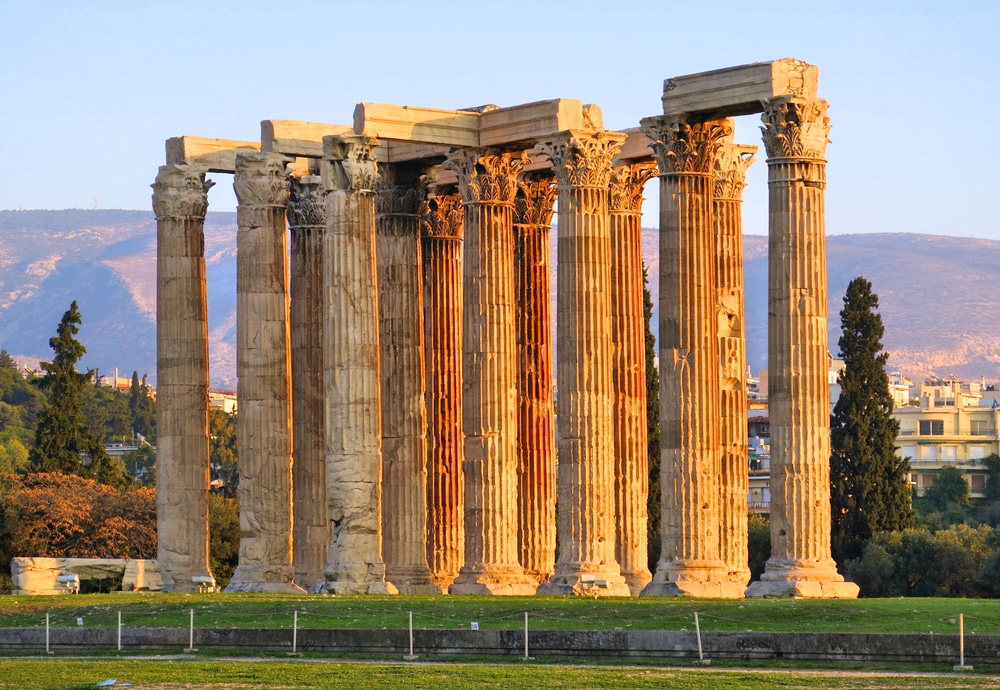 Source: poludziber / shutterstock
Source: poludziber / shutterstockAlthough just a scrap of the Temple of Olympian Zeus is still standing, these 16 massive Corinthian columns (from an original 104) tell you all you need to know about the formidable scale of what was once the largest temple in Greece.
Work on this ambitious project began under the Athenian tyrants in the 6th century BCE and would not be completed until the time of Hadrian in the 2nd century CE.
After centuries of abandonment construction began again in 174 BCE, under Antiochus IV, who ordered the worship of Zeus as the supreme God.
The fluted columns were carved from high-end Pentelic marble, measuring 17 metres in height and two metres in diameter. These stood in a double row, as you’ll see at an impressive group on the south-east corner, holding up pieces of the entablature.
13. Stavros Niarchos Foundation Cultural Centre
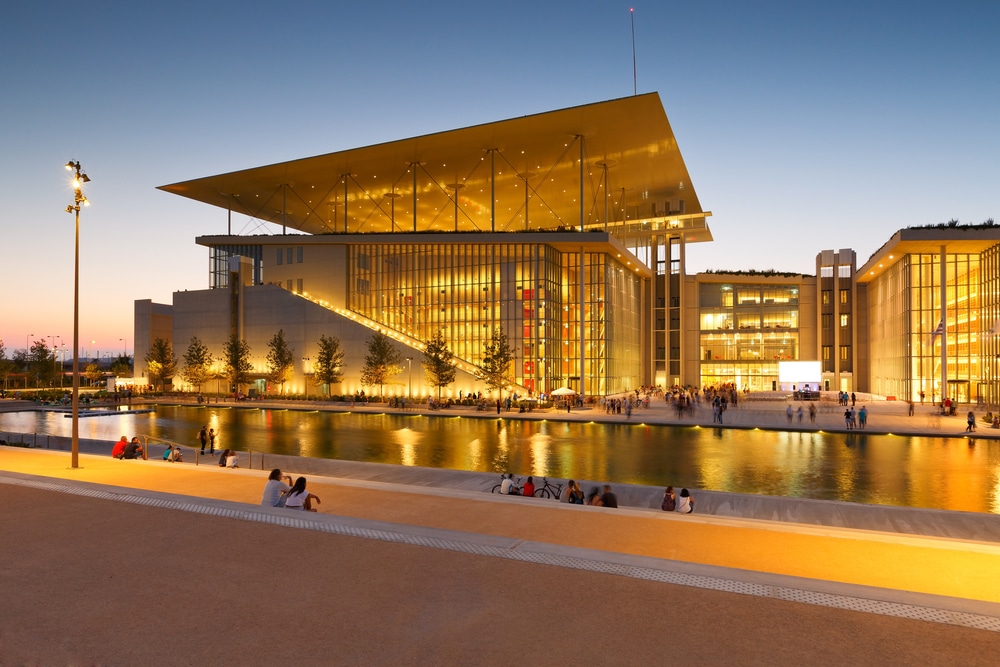 Source: Milan Gonda / shutterstock
Source: Milan Gonda / shutterstockIf you’re in need of a contemporary palate cleanser during a trip dominated by ancient monuments and art, there’s a breathtaking architectural complex down in the Palio Faliro neighbourhood.
The centre, designed by Renzo Piano and opened in 2016 is at the top of a gradual slope on a formerly abandoned plot of land with a far-reaching view of Athens and the sea.
The surrounding 21-hectare park has a matrix of straight gravel walkways between beds of colourful and aromatic indigenous plants, historic olive trees, laurels, cypresses, carob trees and a large central lawn for public gatherings.
Emerging from the ground at the uppermost section are the buildings for the Greek National Opera and the National Library of Greece.
If you’re here for a bit of sightseeing you can register online for a 30-minute tour of this cutting-edge architecture, or a one-hour tour of the exquisite park around it.
Website: https://www.snfcc.org/
14. Temple of Hephaestus
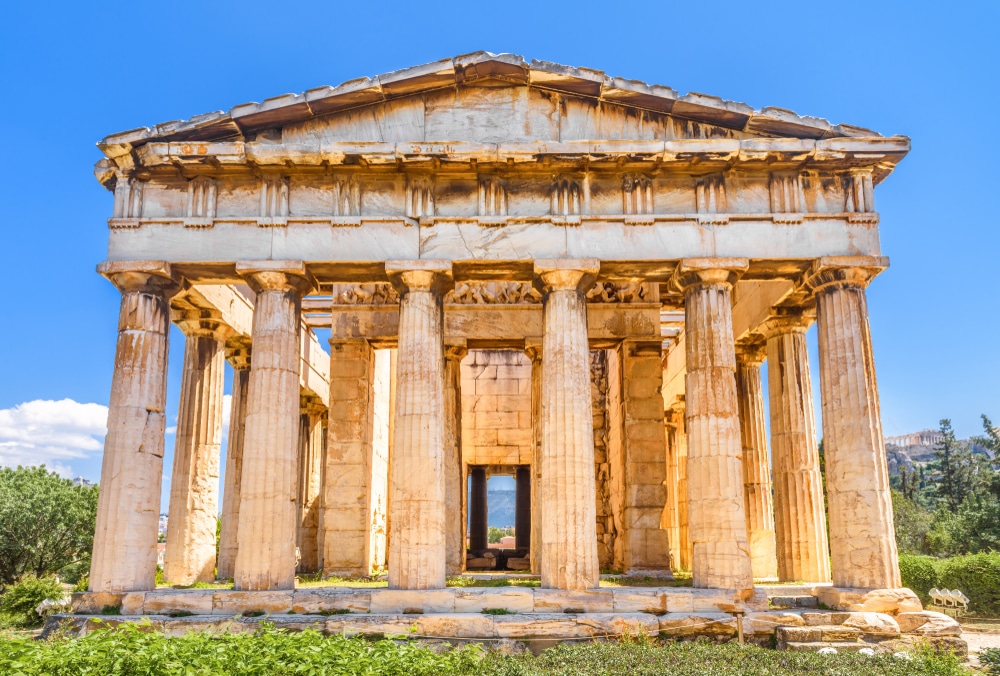 Source: Viacheslav Lopatin / shutterstock
Source: Viacheslav Lopatin / shutterstockResting on a 65-metre rise to the north-west of the Agora is a Doric temple from the 5th century BCE in a fantastic state of preservation.
The Temple of Hephaestus went up during the same programme of construction under Pericles (495-425 BCE) that produced the Parthenon.
The reason for its longevity is that from around 700 CE until the 19th century the building served as a church, dedicated to St George.
The structure is almost 32 metres long and a little under 14 metres wide (6 columns by 13 columns), and composed of Pentelic marble, with some Parian marble on its sculpture.
Hephaestus, god of craftsmen, metalworking and fire, and Athena, goddess of warfare, handicraft and wisdom, were jointly worshipped here.
Although the architectural sculpture is weathered almost all of it is still in situ, showing the Birth of Athena, Return of Hephaestus to Olympus, the Nereids Eurynome and Thetis, the Labours of Heracles and Theseues, as well as the battle of Theseus with the Pallantides.
15. Museum of Cycladic Art
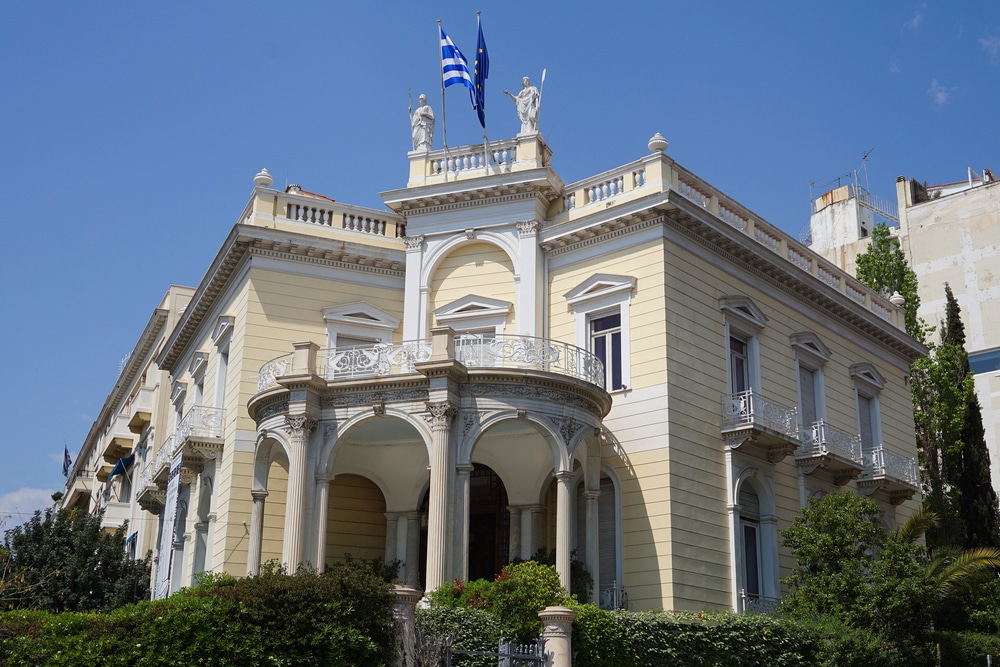 Source: Aerial-motion / shutterstock
Source: Aerial-motion / shutterstockAn exciting repository for Ancient Greek art, this museum opened in the heart of Athens in the 1980s as a space to show off the antiquities gathered by the couple Nicholas and Dolly Goulandris since the early 1960s.
As the name tells you, the museum puts an accent on art from Cycladic island culture that came to the fore in the 3rd millennium BCE, with one of the finest private collections in the world.
The permanent exhibition presents vases, weapons and tools, and it’s easy to see the influence the enigmatic, pared-down Cycladic marble figurines had on 20th-century sculptors like Giacometti, Hepworth and Henry Moore.
Also riveting is the collection of Ancient Cypriot Art, arranged in an interactive exhibition on the third floor. The museum also acquired the neighbouring Stathatos Mansion (1895), linked to the main building by a glass passage and used for high-profile temporary exhibitions.
Ai Wei Wei, Picasso, Lynda Benglis, Cy Twombly and Paul Chan are a few of the contemporary artists featured in temporary shows recently.
Website: https://cycladic.gr/
16. Filopappou Hill
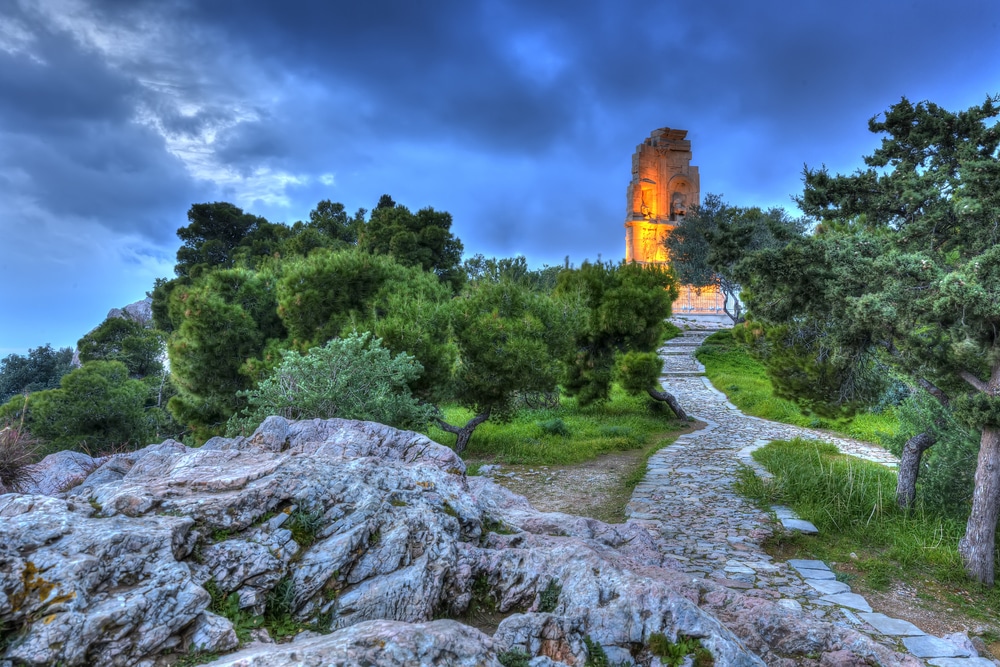 Source: Anastasios71 / shutterstock
Source: Anastasios71 / shutterstockThe ultimate vantage point, the 147-metre Filopappou Hill gives you views right across the city, as far as the mountains hemming the basin, like Parnitha to the north and Hymettus to the east.
Filopappou Hill is also a quiet haven, under a mantle of pine, cypress and olive trees and woven with paths that will carry you up to the highest point.
On the way, you may pass a set of rock dwellings, purported to be where Socrates was imprisoned. At the top, as well as that dramatic panorama of Athens, you’ll see the marvellous Philopappos Monument from the early second century CE.
This mausoleum and monument was erected for the namesake prince of the Kingdom of Commagene and prominent Athenian citizen, who lived from 65 – 116 CE.
Two thirds of the facade survives, including the remnants of statues for Philopappos (centre) and his grandfather, king Antiochus IV of Commagene (left). These sit above a frieze showing Philopappos as a consul, riding in a chariot.
17. Temple of Athena Nike
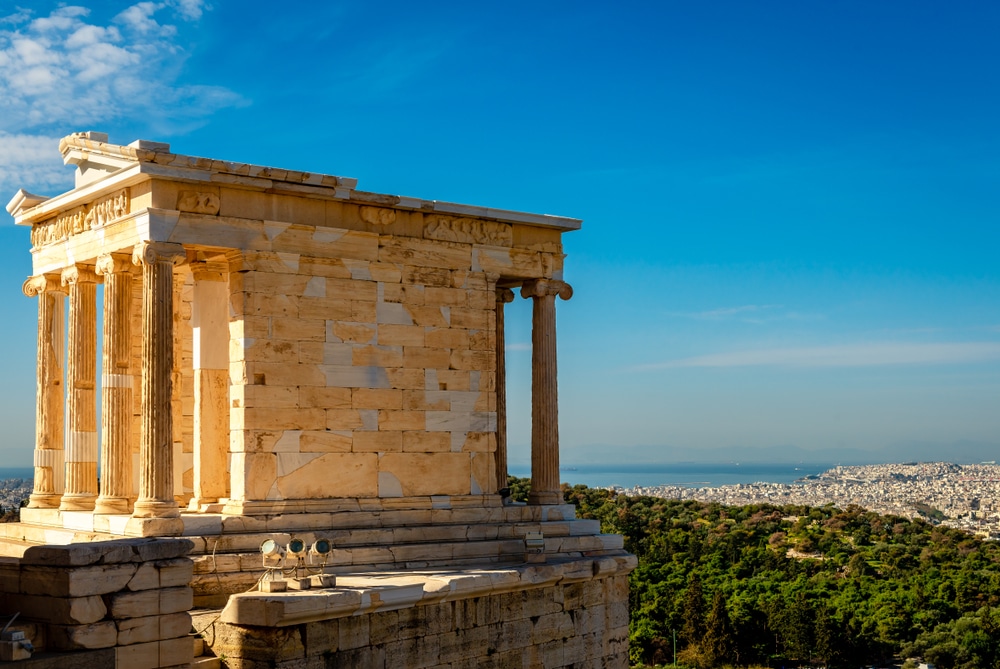 Source: Apostolis Giontzis / shutterstock
Source: Apostolis Giontzis / shutterstockTo the right of the entrance to the Acropolis, on the south-west side is a temple from the Ionic order posted atop a lofty bastion.
At this height there’s a great view of the Herod Atticus Odeon just below. This monument went up around 420 BCE and is dedicated to Athena Nike, worshipped as the goddess who stood by Athens in time of war.
It is thought that this spot had long been the location of a place of worship for a war god or goddess, going back as far as the Bronze Age. And that cult eventually merged with the cult of Athena Nike around the 6th century BCE when an Archaic temple was built here, later pulled down by the Persians in 480 BCE.
The current Classical temple is on a smaller scale than the other monument on the Acropolis and is a four-column structure with a colonnaded facade on both sides.
A frieze on the bastion’s parapet is the origin of the sublime wet drapery relief of Nike adjusting her sandal, housed in the Acropolis Museum.
Meanwhile Olympian gods and goddesses and battle scenes from the temple’s entablature frieze are on show at both the Acropolis Museum and British Museum.
18. Heron Atticus Odeon
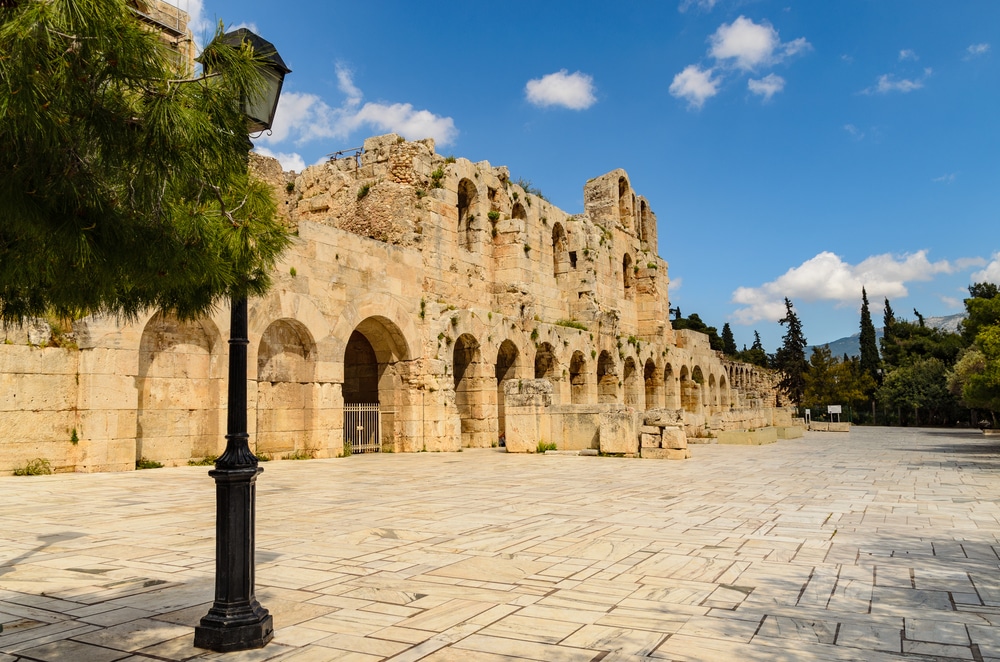 Source: vivooo / shutterstock
Source: vivooo / shutterstockIn the 1950s this Roman theatre on the south-west side of the Acropolis was restored and turned into an extraordinary stage for music performances, reviving the monument’s original purpose.
The Herod Atticus Odeon is the iconic main location for the Athens Festival, from May to October, and Maria Callas, Frank Sinatra, Luciano Pavarotti, Diana Ross, Patti Smith and Ennio Morricone are just a small selection of the many artists to have performed here over the last 70-odd years.
With a capacity of 5,000, the original Odeon went up in 161 BCE, and was commissioned by the politician Herodes Atticus as a tribute to his wife, Regilla.
The theatre made it through to 267 CE, when it was destroyed by the Heruli. In those times the steep audience stands were covered by an opulent Cedar of Lebanon roof.
19. Benaki Museum
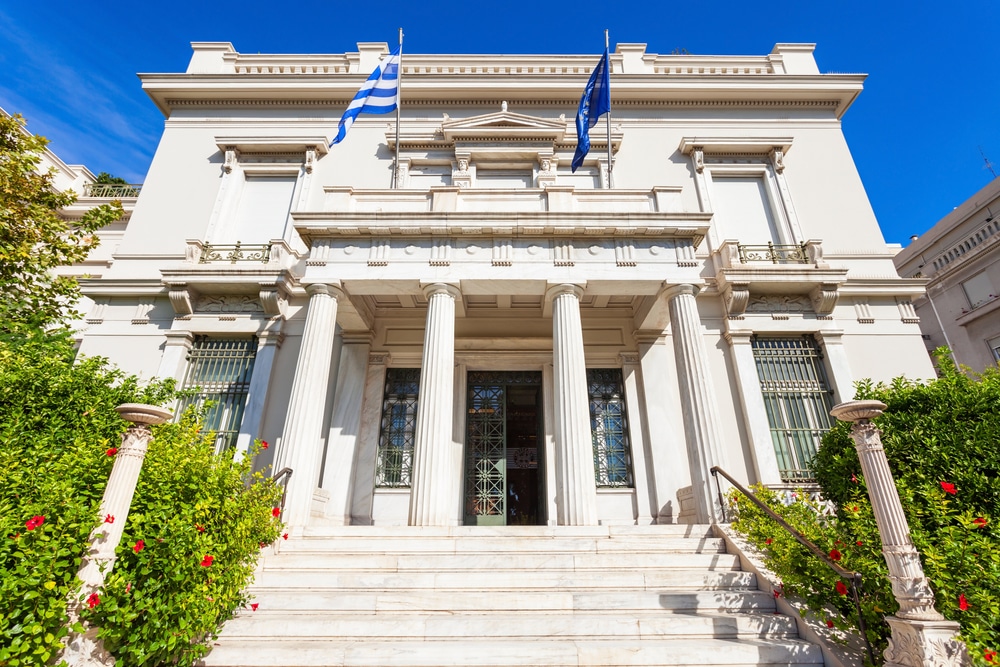 Source: saiko3p / shutterstock
Source: saiko3p / shutterstockIn 1930 the art collector Antonis Benakis donated his massive art collection along with the Neoclassical family mansion on Queen Sofias Avenue to the Greek state.
The museum is named in honour of his recently deceased father, the merchant and politician Emmanuel Benakis (1843-1929). What awaits you in the Benaki Museum is an enthralling survey of Greek art and culture from prehistory to the modern period.
This is presented in chronological order and comprises astounding prehistoric, Ancient Greek and Roman antiquities, beginning with a hoard of Mycenaean jewellery and taking you up to splendid Roman marble portraits.
There’s also a rich array of icons, frescoes, reliefs, ceramics, glass, medals, enamel and coins, spanning the 1,000-year lifespan of the Byzantine Empire.
Finally, in an assortment of more recent Historic Heirlooms are exciting pieces like Lord Byron’s pistols, manuscripts by eminent Greek poets and weapons and Battle Standards from the Greek War of Independence (1821-1830).
Website: https://www.benaki.org/
20. Byzantine and Christian Museum
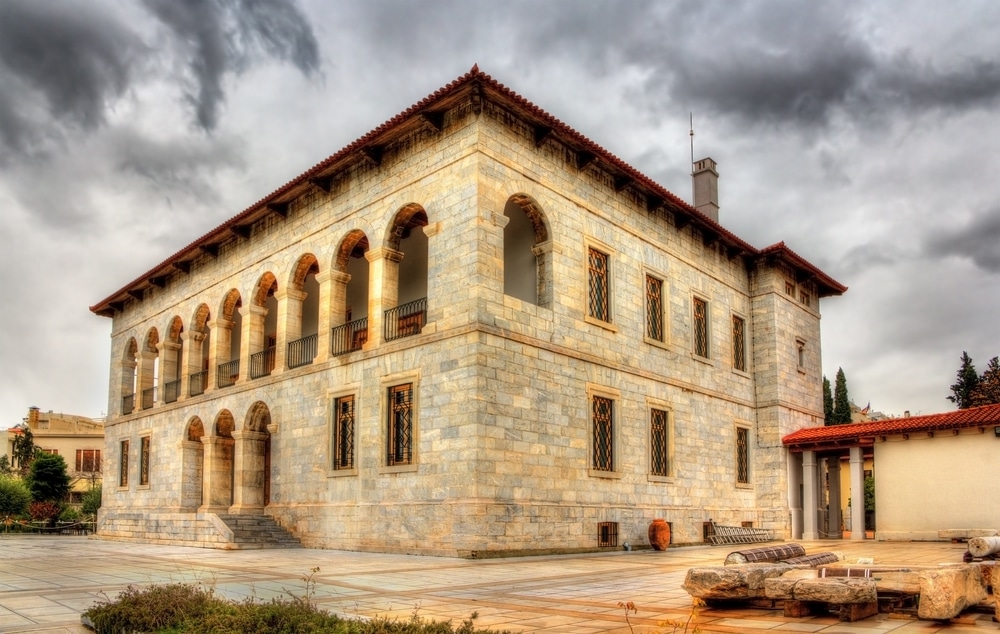 Source: Leonid Andronov / shutterstock
Source: Leonid Andronov / shutterstockChronicling the period from the 3rd century CE to the Early Modern Age with the help of an extremely rich collection, the Byzantine and Christian Museum is one of the top museums in its field in the world.
The venue is Villa Ilisia, built in the 1840s for the Duchess of Plaisance. Here you can trace the origins of the Byzantium, get to know the structure, politics and art of Byzantine society, find out about the fall of Constantinople in 1453 and see how Byzantine forms are echoed in modern art.
There’s a lot of material to peruse, like pottery, statuary, steles, architectural vestiges, icons, manuscripts, glassware, jewellery, liturgical items, and frescoes that have been painstakingly relocated to these galleries.
Website: https://www.byzantinemuseum.gr/
21. Syntagma Square (Constitution Square)
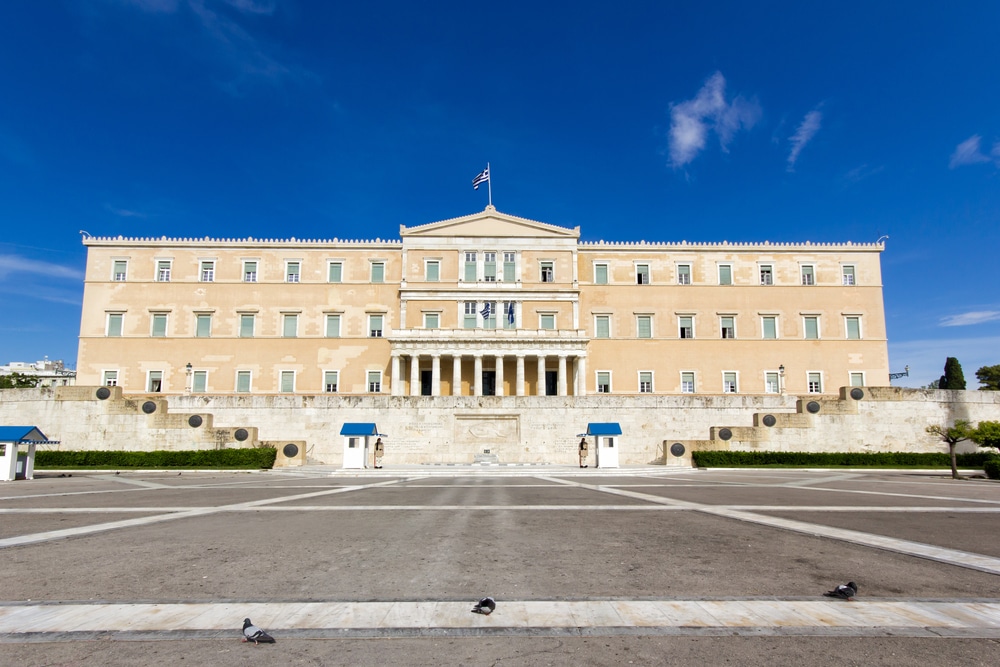 Source: smoxx / shutterstock
Source: smoxx / shutterstockThe political and transport hub of modern Athens dates from the time King Otto switched the capital to Athens in the 1830s, and sits before the Neoclassical Old Royal Palace (1843).
This ceremonious plaza is named for the constitution that Otto was forced to grant, following a military uprising in 1843 that ended with soldiers gathering in front of the palace steps, just after he moved in.
The square remains at the very soul of Greek politics as the palace has been the seat of the Greek Parliament since 1934.
Some big moments in modern Greek history have gone down on this plaza, like Prime Minister Georgios Papandreou epochal Speech of Liberation in 1944 and mass protests during the Greek Government Debt Crisis between 2010 and 2012.
22. Monastiraki
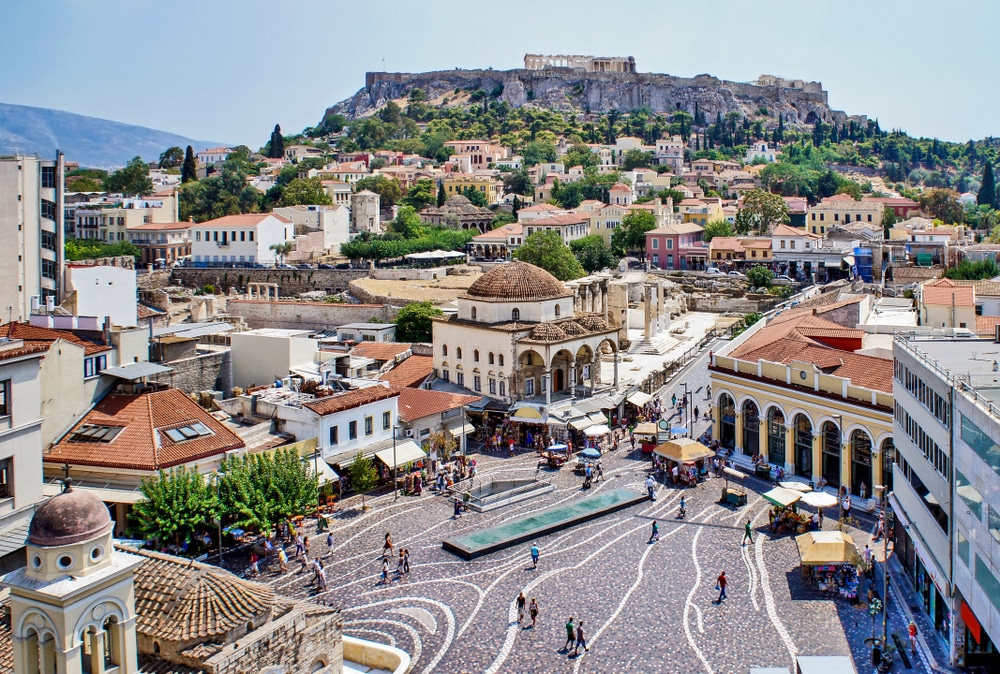 Source: Dimitris Panas / shutterstock
Source: Dimitris Panas / shutterstockWest of Syntagma Square is a hectic market district centred on a labyrinthine bazaar, bursting with antique and souvenir shops.
It can take a bit of local knowhow and a lot of legwork to make a real find, be it an interesting piece of sculpture or hand-painted pottery.
There’s a flea market, heaving with Athens residents and tourists on Sundays, and if you need to take a breather you can take time out at one of the many cafe and restaurant terraces.
Monastiraki also has a great deal of historical interest. For one thing, the square’s name comes from a long-gone monastery, the 10th-century church for which can still be found facing the metro station.
Commanding Monastiraki Square is the dome of the former Tzistarakis Mosque, built in 1759 and today an annexe for the Museum of Greek Folk Art.
23. Roman Agora
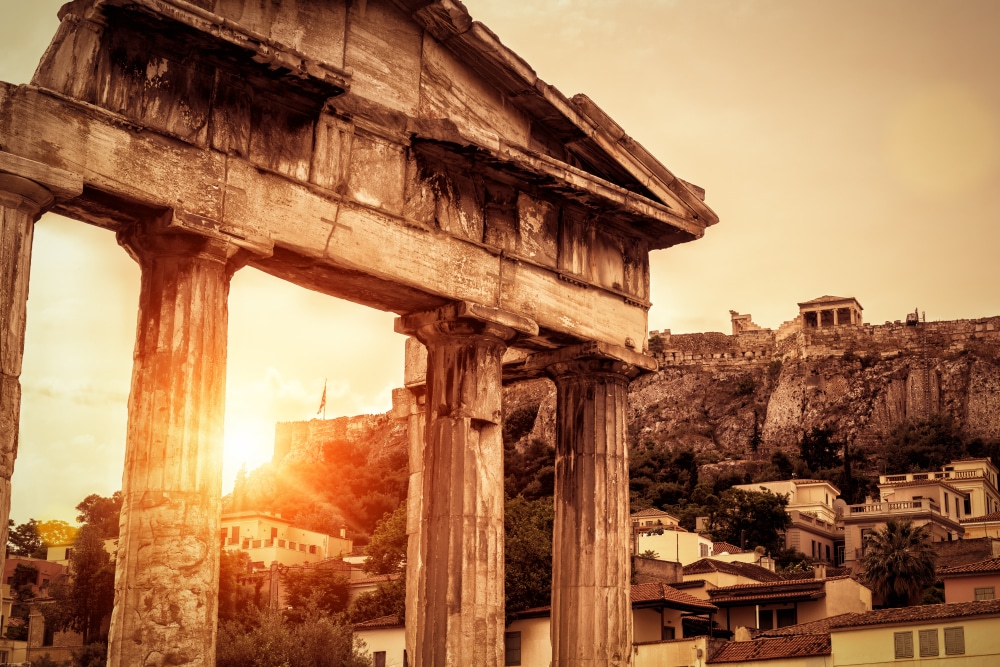 Source: Viacheslav Lopatin / shutterstock
Source: Viacheslav Lopatin / shutterstockThe Roman forum, the successor to the Ancient Agora, is around 100 metres to the east and has a quadrangular plan. Within that was a peristyle with double halls on rectangular footprint, and you can see the weathered remains of those columns today.
As the beating heart of daily life, this is where much of the business in Roman Athens was hashed out, and it helps to imagine the imposing buildings fringing the forum 2,000 years ago.
These include Hadrian’s Library, parallel and occupying a plot of the exact same dimensions, and the magnificent Odeon of Agrippa, a concert hall that could seat 1,000 people.
At the east end is the astounding Tower of the Winds (c. 50 BCE), with sundials, a water clock and weather vane, and considered the world’s first meteorological station.
24. Anafiotika
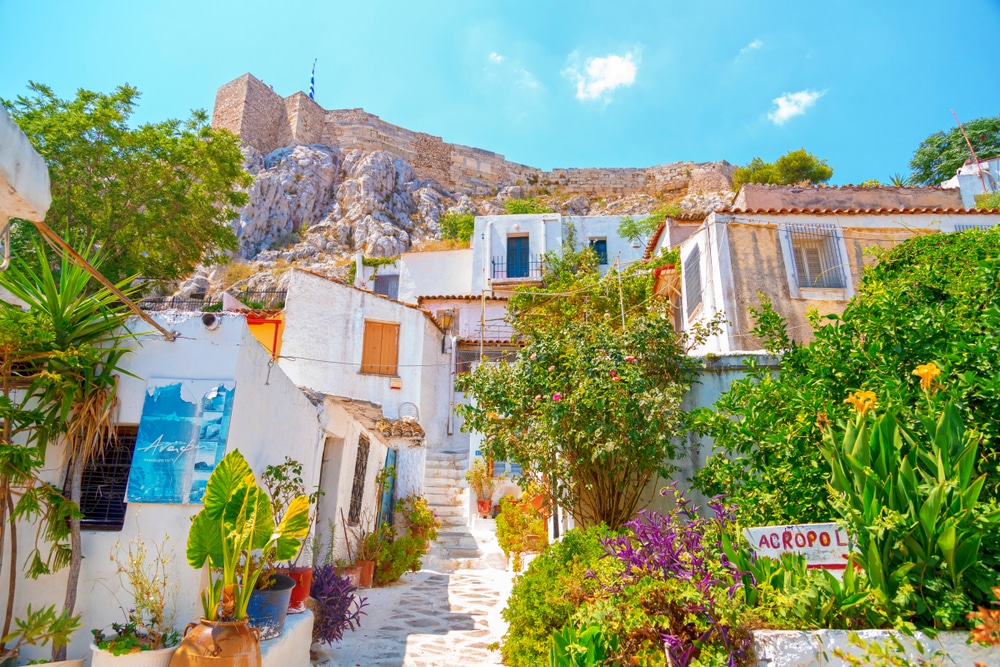 Source: ColorMaker / shutterstock
Source: ColorMaker / shutterstockTight against the cliffs on the north-east side of the Acropolis is a charming neighbourhood of whitewashed houses, wreathed with bougainvillea and divided by steep stairways.
If Anafiotika looks like something from an island in the Aegean, that’s no coincidence as the neighbourhood was built by settlers from Anafi, recruited to work on King Otto’s palace in the 1830s.
These were followed by skilled tradesmen from across the Cycladic Islands, most participating in the reconstruction of Athens.
Although a lot of the Anafiotika was cleared to make way for archaeological surveys there are still around sixty houses, clustered around older monuments.
Among them are the 17th-century Church of St George of the Rock (Agios Georgos tou Vrachou) and the 11th-century Byzantine Church of the Transfiguration (Metamorphosis Sotiros), with a grotto carved from the rugged walls of the Acropolis.
25. Byzantine Monastery of Daphni
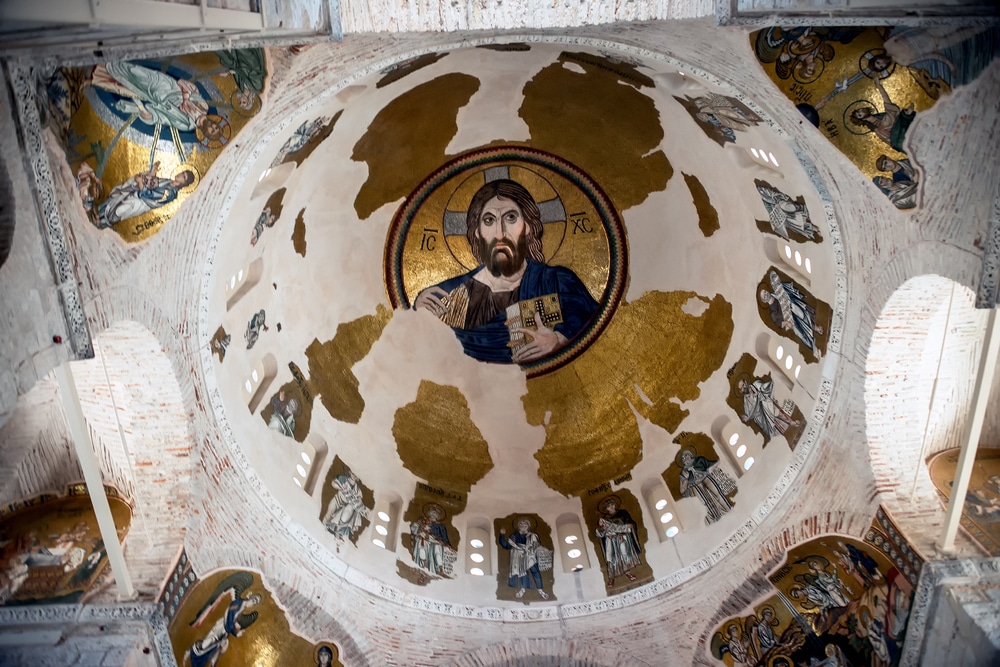 Source: Karl Allen Lugmayer / shutterstock
Source: Karl Allen Lugmayer / shutterstockSlightly removed from the centre of Athens, this UNESCO World Heritage Site is in the north-western suburb of Chaidari about ten kilometres away.
The Daphni Monastery has been here on the fringe of the pine forest since the 7th century CE, and was constructed with reused stone that belonged to the Sanctuary of Apollo at the same location on the Sacred Way, an ancient procession route from the Kerameikos to Eleusis.
The monastery is essential for its stunning 11th-century mosaics composed of radiant tesserae made from colourful glass on a ground-gold background.
In vivid detail there’s an austere-looking Christ Pantocrator in the crown of the main dome, wearing a purple robe and accompanied by 16 prophets at the base of the dome.
Also beguiling are the depictions of scenes from the life of Christ further down on the dome’s pendentives, as well as a variety of images in the narthex, including the Presentation of the Virgin, Judas’ Betrayal and the Benediction.